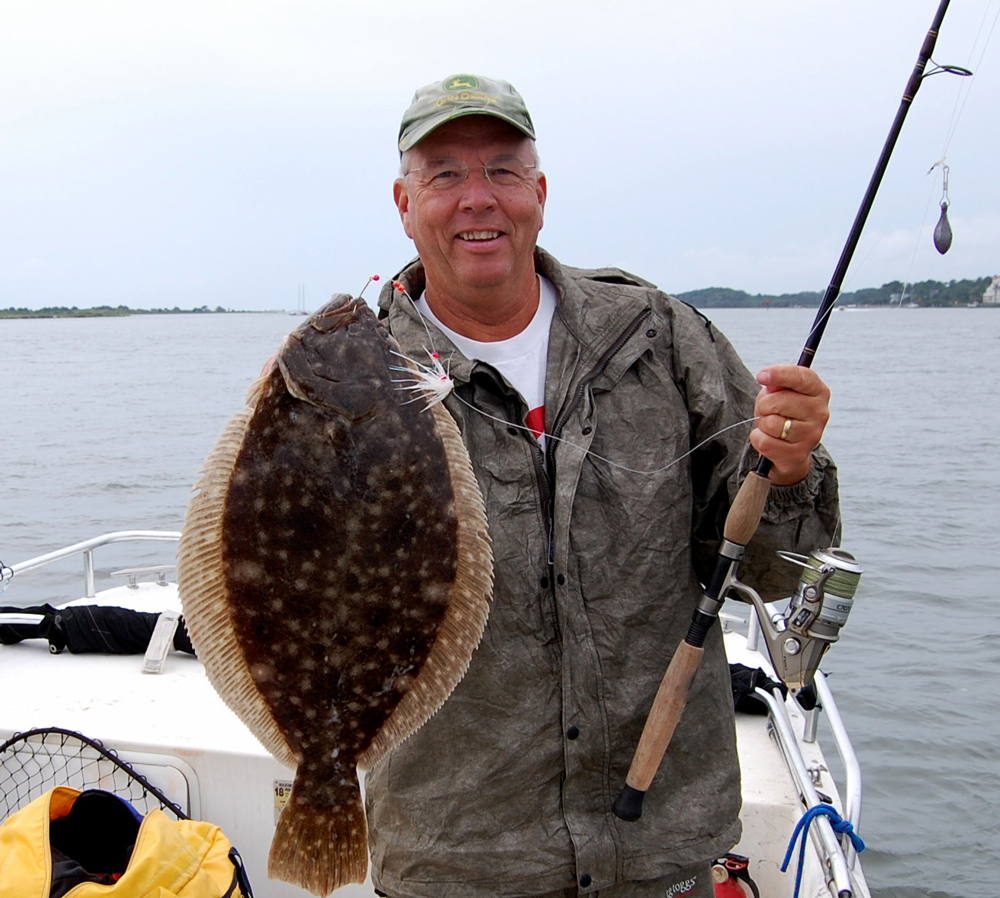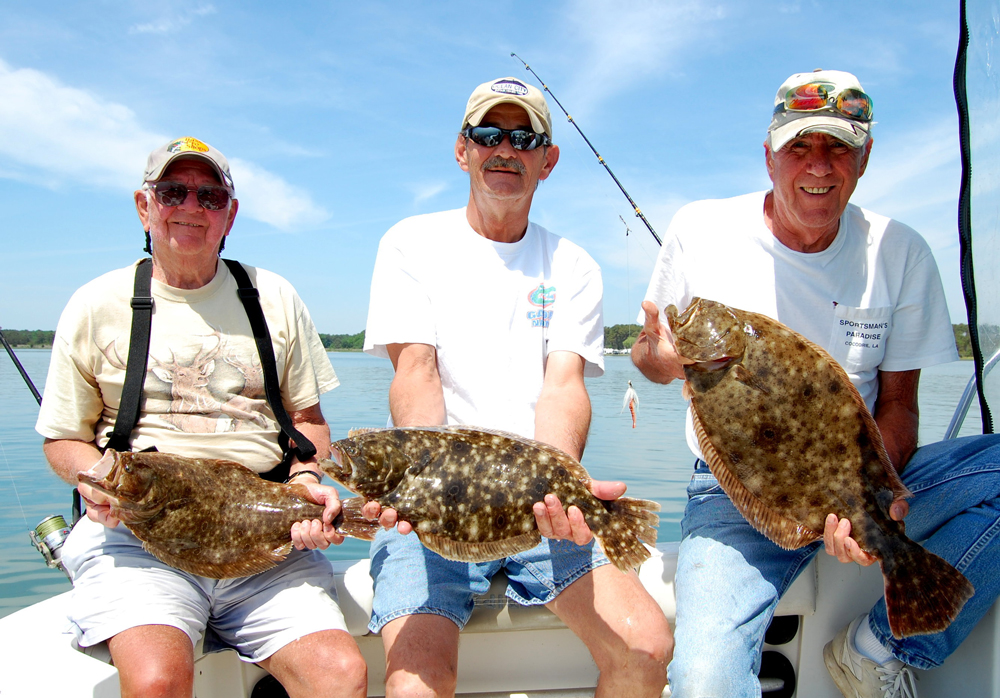April is when flounder begin their spring invasion in earnest. The tackle is rigged, reels are spooled with fresh line, boat covers are torn off, batteries get charged, and fingers get crossed when engine keys are turned — spring's preparation in anticipation of a bent rod is overwhelming. Millions of striped bass are migrating up the Chesapeake to spawn after wintering off the coast. These fish used to attract almost as many anglers, but now the spring trophy season is shut down and fishing for stripers in the Chesapeake doesn't begin until mid-May. Fortunately, spring flounder fishing provides an excellent alternative.

For many fishermen, their spring ritual begins with chasing one of the few fish that has both eyes on the same side of its body. Ideal for lying partially buried on sandy bottoms until deciding to ambush a tasty meal looming above, the flounder actually goes through a metamorphosis to arrive at its final form. As a larva, it swims in an upright position with eyes on opposite sides of the head. During growth, the right eye migrates to the left side of the head. When body length reaches one-half inch, the eye migration is complete and the fish assumes its left-side-up position for life. Flounder also have a unique pigmentation, giving them camouflage ability to match their surroundings. This answers the question that puzzles many anglers when catching flounder of different appearance. Flounder grow rapidly and obtain a length of 12” during the first year of growth. Females can reach 32" during a life span that lasts about 12 years. Males on the other hand only survive about seven years, and grow to about 24”. Don't let their strange appearance fool you; flounder are good swimmers and ferocious eaters.
The Delmarva Peninsula separates the Chesapeake Bay and Atlantic Ocean, where anglers converge at locations on the Virginia ocean-side bearing strange names such as Quinby, Chincoteague, Machipongo, and the best known of all, Wachapreague. The well-earned reputation of these locations needs no explanation within the flounder angling community. But don't overlook better known inlets further north, like Ocean City and Indian River. These locations also produce good spring fishing.
Summer flounder, or fluke as they’re called in many parts of the Mid-Atlantic, move from the ocean depths and invade estuaries in spring. Your success as an angler is dependent upon two factors: water temperature and clarity. As a rule of thumb, when water temps reach the 50 degrees threshold, flounder become active. Depending on how cold or mild winter was, the bite can begin in the end of March on the lower peninsula. However, if water temps rise slowly fish may be caught when water is cooler. Intense afternoon sunlight warms water up on the flats and can be a recipe for catching fish on a falling tide. This is when flounder often can be found in three to four feet of water.
Fishing on a moving tide is a popular method. The last two hours of incoming and beginning of ebb is prime time to be on the water. But as mentioned, early in the season don't overlook the end of ebb tide for working the flats and channel edges where warm water is flowing. One of the most common baits hanging from rod tips is a double bottom rig with a minnow/squid combination. The top hook's leader should be about eight inches long with a bottom hook leader of 24” to 30”. When drifting, this places the top hook just off the bottom and the lower hook drags well behind the sinker. Squid strips should be cut into a “V” shape and split to add enticing movement. Use the largest minnows available; flounder have no problem swallowing big bait. Although not a scientific study, many of us who target flounder have found over the years that gold colored hooks increase catches.

Another choice bait is a bucktail or double-bucktail rig sweetened with a minnow, squid strip or flounder belly. The fact is, flounder normally are not picky eaters when feeding. However, certain bait is preferred at times and improves the look of a kill box. While all the aforementioned options catch fish, anglers may find artificial bait actually out-fishes natural bait. Berkley Jerk Shad or Fishbites Fight Club lures catch flounder. My go-to bait in spring is a double-bucktail rig (chartreuse or white) with three-inch Gulp! shrimp in the copper-penny color.
When the current and wind cooperate, drift fishing can be terrific. However, occasionally the drift is too fast, nonexistent, or just doesn't allow you to work a favorite edge. During these times alternative techniques produce fish. Trolling can be very productive along with back-trolling, which gets its name from trolling into or across strong currents. This allows the bait to move slowly along the bottom when the tide is ripping. Both trolling and back-trolling provide the opportunity to concentrate on prime areas.
Flounder are not a school fish but do tend to congregate in the same area or depth. Once a fish is caught, work the area thoroughly before moving on in search of more fish. If you find the majority of bites coming on turns, you’re trolling too fast. Keep speed around one knot and use only enough weight to "feel" the bottom. A flounder often grabs a bait and holds on before swallowing. The bite may feel as if the line is snagged or has picked up debris. On the bite immediately drop back the rod tip, allowing the flounder to swallow the bait, to increase your hook-up percentage. The standard top/bottom rig mentioned earlier may be used to troll as well as a double-bucktail rig. Just be sure the rig is bouncing on bottom. Another option is to use a three-way swivel with 12” sinker along with five-foot leader. Attach your favorite bucktail or a skirt and spinner blade to enhance bait presentation.
Anglers who spring into action on the Eastern Shore may observe a few friendly smiles on nearby boats. But rest assured, there will not be the magnitude of boats or anglers that were once seen chasing April stripers over in the Chesapeake!
- John Unkart is author of Offshore Pursuit and Saltwater Tales, available on Amazon.
Editor's note: This article was originally published May 12, 2017, and was last updated on May 8, 2024.